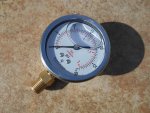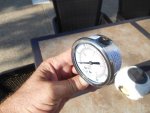My 3 yr old pressure gauge is slow to rise when the pump is first turned on and slow to fall when it is turned off (but it does eventually go back to zero when off.) After a minute or so it gets to where I would expect the pressure to be, is consistent, and I have movement through the returns. Vacuuming is fine. I suspect the gauge is bad, but is there anything else I should check before I order a new one? I took it off and cleaned inside it and inside the filter fitting with a straw cleaner brush...no change.
Are "off-brand" gauges as good as a name brand or should I stick with a name brand (Hayward is what i have now)? I don't have a preference to buy one over the other, but an off brand doesn't save money if you buy it twice as often or it doesn't work as well. If you have had good experience with an off-brand, what was the name?
Thanks!
Sent from my XT1060 using Tapatalk
Are "off-brand" gauges as good as a name brand or should I stick with a name brand (Hayward is what i have now)? I don't have a preference to buy one over the other, but an off brand doesn't save money if you buy it twice as often or it doesn't work as well. If you have had good experience with an off-brand, what was the name?
Thanks!
Sent from my XT1060 using Tapatalk



